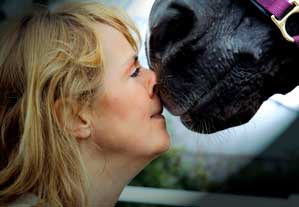|
|
|||
|
A
New
Way of Talking By Marta Williams
|
|
||
|
FREE NEW! Natural Weight Loss
Program recommended by The Share Guide
|
Each of us has the ability to communicate intuitively with animals and nature--to converse with other life forms by mentally exchanging thoughts, emotions, and images. I believe this is an ancient, innate characteristic of all life, the foundation of spoken and written words, and the common link between all species. Modern-day humans are born with this ability, but we are subtly conditioned to repress it as we grow up. Yet it’s possible to recover your intuitive skill; I did and I now teach others to as well. Intuitive communication is not the same as reading body language. It is something completely different: the ability to send and receive thoughts, images, feelings, and other sensory data mentally, without using any sound or gesture. Most of us can relate to the idea of intuition and have had hunches or gut feelings about things. Intuition is a useful survival tool, and even though suppressed, it will often surface in a crisis to inform us of some threat or critical event. Animals recognize the survival value of intuition, and never disconnect from it. Intuitive communication can be done at a distance, and you don’t have to see or know the animal you wish to speak with. Here is an example of how it works. At a workshop held at a farm, my students interviewed four Norwegian fjord horses. We knew the horses were female, and we could see that one was young and one was pregnant. The students mentally spoke with the horses and then got feedback from the woman who regularly cared for them. This woman was skeptical, but as the students relayed their questions, she became amazed. One student asked, “Was that mare brought in from another farm? Did they use her for jumping and then get rid of her because they wanted a bigger horse?” The caretaker nodded. Another asked, When they got rid of her, did they get a big black Friesian horse instead? That’s the image the mare showed me.” Again the caretaker nodded. More questions followed, and most of the information the students got from the horses turned out to be accurate. There are two parts to intuitive communication: sending information and receiving information. Sending is by far the easiest. Try this experiment: For a two week period talk to your animal out loud as if he or she understands you completely. Tell your animal how you feel, or how your day went, just as you would converse with a person. Politely ask your animal to change any behaviors that might be bothering you, and if there is something you would like your animal to do, just ask for it. Keep a written record of any changes in your animal’s behavior. If your animal complies with your requests and suggestions, be sure to give lots of feedback and appreciation. Many people who try this exercise discover that it works so well they make it a permanent change in the way they relate to their animals. After you’ve been talking for a few weeks, you can ask your animal to do something or act in such a way as to provide you with indisputable proof that you have been heard and understood. For example, my sister asked her food-obsessed horse to leave his hay and come give her a kiss, which he did to her complete astonishment. Receiving intuitive information is harder than sending, because you have to learn to recognize the incoming information. Once you contact an animal intuitively and initiate a dialogue, all information that pops into your head at that point is potentially about, or directly transmitted by, the animal. The information can come in the form of visual images, feelings (both emotional and physical), ideas, and words or phrases that pop into your mind. Oddly enough, it can be easier to receive information intuitively from an animal you don’t know than from one you do. That’s because you know so much about your own animals that it may be impossible to get around the feeling that you’re just making things up. To counteract this, I recommend that you try this experiment: Ask your animal, Do you have a question for me? If a question pops into your head, no matter what it is, assume it came from your animal and answer it as best you can. You may find that you and your animal end up in a back-and-forth discussion of a subject that your animal has chosen. If your animal doesn’t have a question or you just don’t get anything, let it go and tell your animal that you will ask again another day. Adapted from Beyond Words, ©2005 by Marta Williams, reprinted with permission of New World Library, Novato, CA. For more info visit www.martawilliams.com Shop Books & CD's related to Animal Communication Natural Weight Loss Program recommended by The Share Guide: learn more MORE
HEALTH ARTICLES Home Shop |
||
|
|
|||
|
|
|
||

